
APPLIED IMMUNOHISTOCHEMISTRY & MOLECULAR MORPHOLOGY
metrics 2024
Transforming pathology through rigorous scientific inquiry.
Introduction
Applied Immunohistochemistry & Molecular Morphology, published by Lippincott Williams & Wilkins, stands as a pivotal resource within the fields of histology, medical laboratory technology, and pathology. With an ISSN of 1541-2016 and an E-ISSN of 1533-4058, this journal has been contributing significant research and advancements since its inception in 1996. It serves a diverse audience, including researchers, professionals, and students, aiming to enhance the understanding of immunohistochemical techniques and molecular morphology. Recognized for its quality, it holds category quartiles of Q3 in histology and Q2 in medical laboratory technology and pathology and forensic medicine as of 2023. The journal's rigorous peer-review process ensures that only the most impactful findings are disseminated, thus advancing the education and practice in these critical domains of study. Though it is not an open-access journal, it remains essential for keeping abreast of the latest methodological innovations and applications in pathology and laboratory science, as evidenced by its respectable Scopus rankings and the continual convergence of groundbreaking research published through 2024.
Metrics 2024
 0.54
0.54 1.30
1.30 1.50
1.50 80
80Metrics History
Rank 2024
Scopus
IF (Web Of Science)
JCI (Web Of Science)
Quartile History
Similar Journals

PATHOLOGY & ONCOLOGY RESEARCH
Illuminating Pathways in Cancer ResearchPATHOLOGY & ONCOLOGY RESEARCH is a prominent international journal published by FRONTIERS MEDIA SA, dedicated to advancing the fields of pathology and oncology. Operating from the Netherlands, with a distinguished address in Switzerland, this journal plays a crucial role in disseminating significant research findings and insights from 1995 to 2024. With an ISSN of 1219-4956 and E-ISSN of 1532-2807, it is indexed in well-respected databases, facilitating access to a global audience of researchers and practitioners. Notably, the journal ranks in the Q3 category for Cancer Research (2023), while being recognized in the Q2 categories for both Medicine (Miscellaneous), Oncology, and Pathology and Forensic Medicine, reflecting its authoritative status in these vital disciplines. Scopus rankings further highlight its influence, with notable percentiles across various fields. Although it follows a subscription model, the journal remains committed to publishing high-quality, peer-reviewed research that bridges conceptual gaps and encourages further exploration in oncology and diagnostic pathology, making it an indispensable resource for academics and professionals engaged in these critical areas of medicine.

PATHOLOGICA
Unveiling Insights in Pathology and Forensic Medicine.PATHOLOGICA is a leading academic journal dedicated to the field of pathology and forensic medicine, published by PACINI EDITORE. With a rich history dating back to its inception in 1945, the journal has consistently contributed to the advancement of knowledge in these vital areas of medical research and practice. Currently ranked in the Q1 quartile for Pathology and Forensic Medicine and holding an impressive position as #42 out of 208 in the Scopus rankings, it reflects a significant impact within the academic community, boasting an 80th percentile ranking. The journal is committed to publishing high-quality, peer-reviewed articles that explore innovative research findings and clinical advancements, making it an essential resource for researchers, clinicians, and students alike. Though it does not offer open access, PATHOLOGICA continues to foster scholarly communication by disseminating cutting-edge research findings, thus playing a pivotal role in enhancing pathology education and practice worldwide.

AMERICAN JOURNAL OF DERMATOPATHOLOGY
Unveiling the Mysteries of Skin DisordersAMERICAN JOURNAL OF DERMATOPATHOLOGY, published by Lippincott Williams & Wilkins, is an essential resource for professionals and researchers engaged in the fields of dermatology, pathology, and forensic medicine. Established in 1979, the journal aims to disseminate cutting-edge research and advancements pertaining to the microscopic examination of skin disorders. With an esteemed impact factor that positions it well within the Q3 category of dermatology and pathology as of 2023, the journal ranks #81 out of 142 in dermatology and #130 out of 208 in pathology according to Scopus. Although it does not currently offer open access options, the journal provides valuable insights and substantial contributions to the understanding of dermatopathology, making it a vital tool for academics, clinicians, and students seeking to stay abreast of the latest findings and practices in the field. Its commitment to high-quality research continues to foster a deeper understanding of skin diseases, enhancing patient care and scientific inquiry alike.
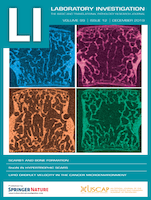
LABORATORY INVESTIGATION
Transforming Laboratory Findings into Clinical SolutionsLaboratory Investigation is a premier academic journal published by Elsevier Science Inc, specializing in the fields of Pathology, Forensic Medicine, Cell Biology, and Molecular Biology. With its ISSN 0023-6837 and E-ISSN 1530-0307, this journal has been a significant contributor to scientific discourse since its inception in 1952, converging into its current form by 2024. It holds an impressive standing in its respective fields, featuring a 2023 Journal Rank of Q2 in both Cell Biology and Molecular Biology, and an elite Q1 ranking in Pathology and Forensic Medicine, reflecting its influence and quality of research, as seen in its Scopus ranks—17th out of 208 in Pathology and Forensic Medicine. Although it does not offer Open Access options, the journal remains a vital resource for researchers, professionals, and students who seek to disseminate and engage with high-caliber research findings. The importance of Laboratory Investigation is underscored by its commitment to advancing the understanding of laboratory and translational medicine, paving the way for innovations that enhance clinical practices.

Journal of Hematopathology
Connecting clinicians and researchers for better diagnostics.The Journal of Hematopathology, published by SPRINGER HEIDELBERG, serves as a vital resource in the fields of hematology, histology, and pathology. Established in 2008, this peer-reviewed journal aims to foster the exchange of knowledge among researchers, clinicians, and students by publishing original articles, reviews, and case studies that contribute to the understanding of hematopathological disorders. While the journal currently ranks in the fourth quartile in various categories including hematology and histology, it positions itself as a platform for emergent research and insights, addressing the evolving landscape of blood-related diseases. Although not an open access journal, it provides crucial access to research findings for professionals looking to stay abreast of developments in pathologic diagnostics and therapeutic strategies. As it continues to grow, the journal remains committed to enhancing the knowledge base and scientific discourse in hematopathology.
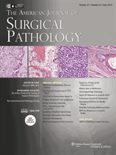
AMERICAN JOURNAL OF SURGICAL PATHOLOGY
Where Cutting-edge Research Meets Clinical PracticeThe American Journal of Surgical Pathology, published by Lippincott Williams & Wilkins, is a premier peer-reviewed journal serving as a vital resource for pathologists, surgeons, and researchers in the medical field. With an impressive impact factor reflective of its esteemed standing in the academic community, the journal ranks in the Q1 quartile for Anatomy, Pathology and Forensic Medicine, and Surgery as of 2023. The journal's Scopus rankings further highlight its significance, placing it within the top tiers in multiple medical disciplines. Established in 1977 and continuing through 2024, its scope encompasses groundbreaking research, critical reviews, and updates in surgical pathology, making it an essential tool for advancing the scientific community's understanding of disease mechanisms and therapeutic approaches. Researchers, clinicians, and students will find both comprehensive studies and innovative insights, ensuring they remain informed about the latest developments in surgical pathology.

ENDOCRINE PATHOLOGY
Elevating Standards in Endocrine MedicineENDOCRINE PATHOLOGY is a premier journal published by HUMANA PRESS INC, dedicated to advancing the understanding of endocrine disorders through innovative research and clinical practices. With an impressive impact factor and consistently ranked in the Q1 quartile across multiple categories such as Endocrinology, Diabetes and Metabolism, as well as Pathology and Forensic Medicine, this journal serves as a pivotal resource for researchers and professionals in the field. The journal covers a broad spectrum of topics related to endocrine pathology, providing insights into mechanisms, diagnostics, and therapeutics that inform both clinical and laboratory practices. Although it does not offer open access, its rigorous peer-review process ensures the dissemination of high-quality, impactful research that shapes clinical strategies and enhances patient care. With distribution spanning from its inception in 1990 to 2024, ENDOCRINE PATHOLOGY stands at the forefront of endocrine research, making it an essential read for anyone involved in the study and treatment of endocrine disorders.
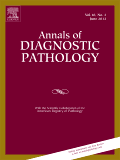
Annals of Diagnostic Pathology
Advancing the Frontiers of Diagnostic Excellence.Annals of Diagnostic Pathology, published by Elsevier Science Inc, is a pivotal journal in the field of diagnostic pathology that has significantly contributed to the advancement of medical science since its inception in 1997. With an ISSN of 1092-9134 and E-ISSN of 1532-8198, this esteemed journal is positioned within the Q2 category in both Medicine (miscellaneous) and Pathology and Forensic Medicine, reflecting its high-quality research contributions, showcased by its ranking at #73 out of 208 in Scopus for the latter category. The journal's scope encompasses various aspects of diagnostic pathology, from innovative techniques to critical reviews of pathologic findings, making it an essential resource for researchers, medical professionals, and students dedicated to enhancing diagnostic accuracy and patient care. Although it does not currently offer open access options, its wide readership and impactful publications continue to influence clinical practices and research agendas. With a convergence period extending to 2024, Annals of Diagnostic Pathology remains a leading platform for disseminating valuable knowledge in this dynamic field.
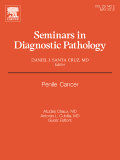
SEMINARS IN DIAGNOSTIC PATHOLOGY
Leading the way in pathology innovation.Seminars in Diagnostic Pathology is a premier journal that has established itself as an essential resource in the field of pathology since its inception in 1984. Published by W B Saunders Co-Elsevier Inc, this journal boasts an impressive Q1 ranking in the pathology category for 2023, placing it in the top tier of medical journals worldwide. With a focus on diagnostic pathology, it offers a platform for groundbreaking research and advancements that bridge the gap between basic science and clinical practice. The journal is committed to publishing high-quality review articles, case reports, and expert opinions that provide valuable insights for professionals, researchers, and students alike. Although it operates on a subscription model, the journal's extensive impact is reflected in its Scopus rank (#56/208), with a remarkable 73rd percentile standing in the pathology and forensic medicine category. The journal's authoritative content not only aids in enhancing knowledge but also fosters an understanding of the evolving challenges and methodologies in diagnostic pathology, making it an indispensable tool for anyone dedicated to excellence in the field.
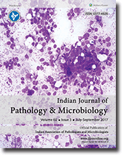
Indian Journal of Pathology and Microbiology
Fostering Collaboration in Pathology and MicrobiologyIndian Journal of Pathology and Microbiology, published by Wolters Kluwer Medknow Publications, is a distinguished open-access journal that has been fostering knowledge dissemination in the fields of pathology and microbiology since 2008. With an ISSN of 0377-4929 and E-ISSN 0974-5130, this journal serves as a critical resource for researchers and practitioners committed to advancing their understanding of medical sciences in India and beyond. Spanning decades of valuable research contributions since its establishment in 1972, it provides a platform for peer-reviewed articles that explore current trends and innovations in medicinal pathology and microbiological studies. Although it holds a Q4 ranking in categories such as medicine and microbiology, it maintains a notable Q3 classification in pathology and forensic medicine, highlighting its relevance to contemporary scientific discussions. Accessible freely to a global audience, the journal plays a pivotal role in enhancing scholarly communication and collaboration, making it an indispensable tool for students, professionals, and researchers alike aiming to contribute to this evolving discipline.